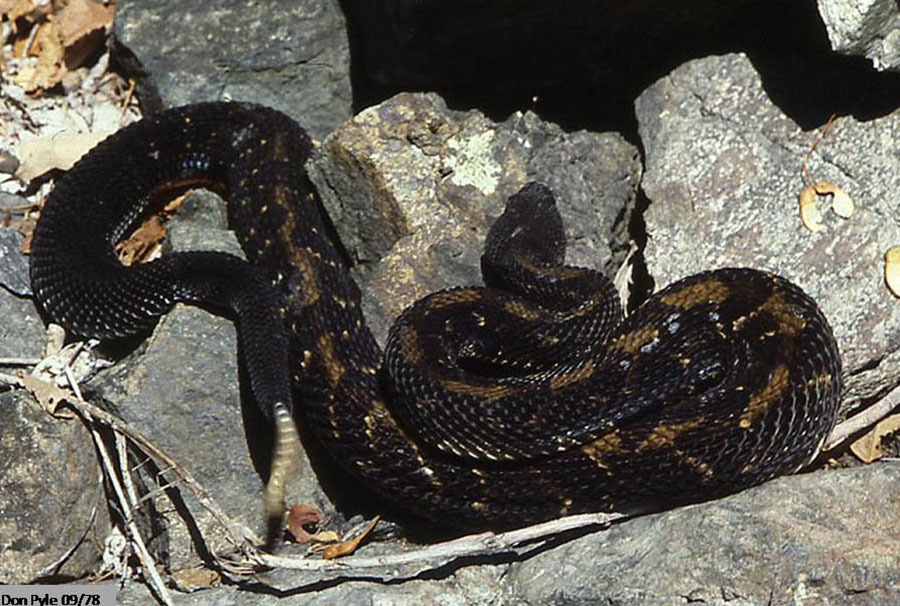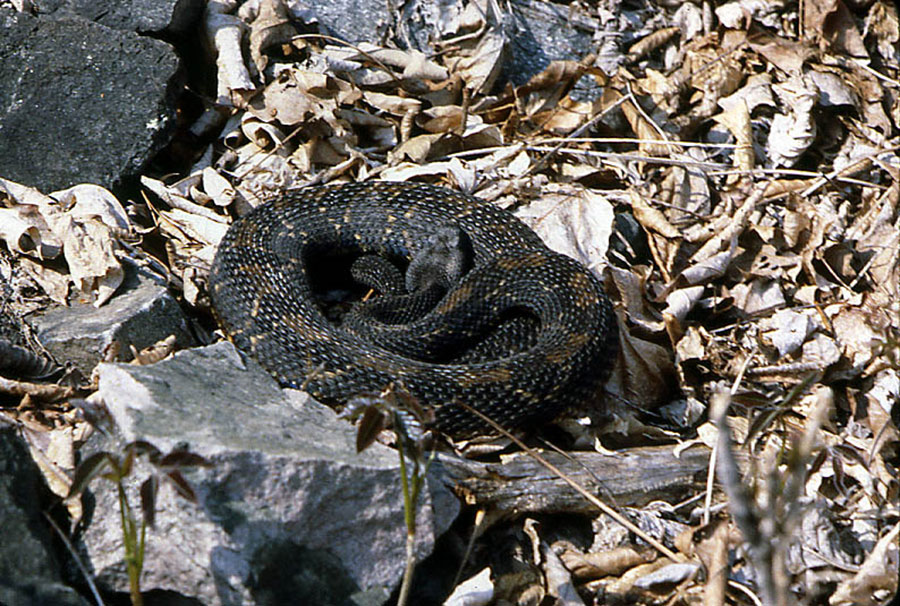This summer, rattlesnakes were on the move, a move that didn’t always work out well for the rattlesnakes.
“Sadly I found two timber rattlers hit by cars on Lake Shore Road this summer,” said Barbara Juh of Whallonsburg. Lake Shore Road runs in proximity to the Split Rock Wild Forest, home to the northernmost den of rattlesnakes in the Adirondacks.
Usually the snakes are content to stay within the close confines of their rocky turf, but every few years, for whatever reason, they decamp for lower elevations, slithering as many as 3 miles from their den, increasing their contact with the public. This has been one of those years.
Conventional wisdom holds that dry summers — of which this was assuredly one — send snakes out of the dry rock in search of water. But Bill Brown, research biologist with the Darrin Fresh Water Institute at Rensselaer Polytechnic Institute, does not believe that to be the case.
He said that rattlers absorb moisture through dew and their prey, and in dry times would be more likely to retreat out of the sun deep in their dens than venture down to lap water out of Lake Champlain.
According to Brown, the more likely reason for the activity is food. Almost like mast, small animals such as chipmunks and mice go through cycles, being less abundant in some years than others. This is probably a down year for those rodents.
As the summer of 2025 proved to be a big year for snakes, one other change was apparent: Timber rattlers receive a lot more public love today than in centuries past. When Dustin Salerno posted a video of an onyx rattler (they’re black at Split Rock, but can be more yellow further south), the one commenter who advised “run over it” was quickly shouted down.
Salerno said he’d heard about the timber rattlers, but was stil surprised to see one out on the road while on his way to a job site.
What to do if you see one
Rattlesnakes are a protected species, rare in the park, but a little more common south, down into the Hudson Valley. They still deserve a wide berth when on the trail in areas known to have dens, according to the Department of Environmental Conservation.
“If anyone encounters a timber rattlesnake in New York, DEC advises to not panic — stop and give it plenty of space by backing away slowly and taking a different route,” a DEC spokeswoman wrote.
Keep a safe distance of six feet or more away from the snake and let them move along on their own, DEC says. Do not kill or collect the snake. Timber rattlesnakes are not aggressive unless provoked. If an accidental bite occurs, seek medical attention immediately or call 911. To report a sighting, or ask questions, contact the local DEC Regional Wildlife Office.
But most hikers have nothing to worry about as populations have declined. A den once existed in the Chazy blueberry barrens in Clinton County, but was hunted out in the last century. Split Rock today remains as the northernmost den, with dens a little more common in the Lake George area.
 Timber rattlesnake photo courtesy of Don Pyle
Timber rattlesnake photo courtesy of Don Pyle
Snakes venturing out
Mountains named “Rattlesnake” exist in Willsboro, Lewis and Jay, although Brown said he hasn’t come across any direct proof that they once supported colonies.Still, snakes in existing dens do get around.
“Movement seems to happen every few years,” Brown said. “I haven’t kept an exact record of it, but right here, where I live (in the Lake George region), I’ve dealt with five different rattlesnakes on the road right near our property. Five rattlesnakes right here is pretty unusual.”
It’s impressive they can range so far, and maybe more impressive that they can find their way back. “They’re never lost,” Brown said. “They seem to know exactly where they’re going and how to get back to the den.”
Brown, who picks up “nuisance rattlesnakes” that show up where they’re not wanted and drives them back to their homes, said the creatures seldom bite unless provoked.
A history of fear
Still, that was probably small comfort in the 19th century before the days of reliable medical treatment, when bites — provoked or not — could be fatal. “I think it goes back from the very beginnings of white colonization,” Brown said. “Here we had a venomous snake that could kill people, yeah, and I think that caused a lot of unreasonable fear.”
There were four recorded fatalities from snake bites in the 1800s in Washington and Warren counties, but there has been only one in New York, in Rockland County, in the 20th century,
Bounties were placed on snakes in the late 1800s, and were substantial enough in Warren and Washington counties (the equivalent of $70 per snake in 1950) that a few individual snake hunters were in some cases able to kill enough snakes to pay their taxes.
These individuals were dedicated to secrecy over the location of the dens, so as not to inspire competition. Not that this was an issue. “No one else really had the stamina or gumption to go out and regularly hunt rattlesnakes,” Brown said.
They would cut off the tails to prove the kill, and when they had enough to make it worth their while, visit town hall for remuneration. Aside from the snakes themselves, no one hated the bounty system more than town clerks, who had to break from their inoffensive work of filing documents and entering numbers in ledgers to count out a big sack of fetid snake tails without gagging.
“Most of the town clerks were women, and it was technically part of their job, but it was certainly not what they signed up for,” Brown said. Nevertheless, they did the job well, and because of that there exists an amazingly accurate picture of 20th century rattlesnake activity.
The best known hunter was perhaps Art Moore of Whitehall, who cut firewood and hunted snakes for a living — and continued even after the bounties ceased in 1971. In 1979, “He was still fooling around with snakes, and he would still have his annual rattlesnake meat parties over there, where dozens of other local people would show up and they would drink beer and eat rattlesnake,” Brown said. “He was still doing that, still collecting enough to show them off, and he had other potential commercial outlets for some snakes.”
Today the location of the dens is kept under close wraps not to make life easier for the snake hunters, but to make it easier on the snakes — human contact seldom works out well for them.
And despite a warming planet, Brown said it’s doubtful that rattlesnakes will form new colonies in the North Country.
“I doubt that climate change will make a difference in their potential dispersal to new denning areas,” he said. “These (dens) seem to have been taken thousands of years ago when the latest northward expansion happened in the wake of the glacial withdrawal. But we’ll see — strange things can happen.”
